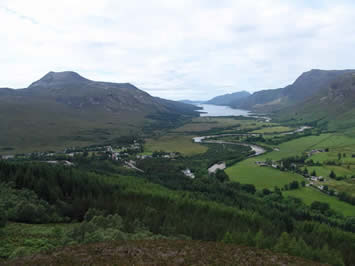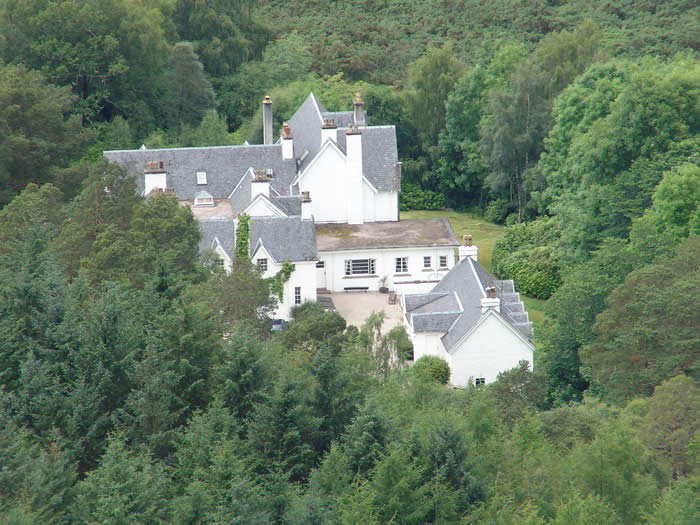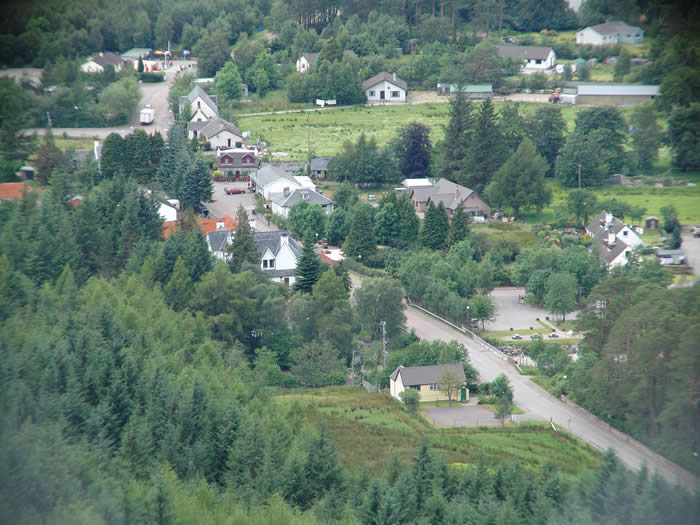The Majors Cairn
High above the A832, just east of the village of Kinlochewe stands a rough cairn of natural stone about five feet six inches in height. Its position atop a small hillock affords a generous panorama over Loch Maree towards Slioch and the hills beyond. |
 |
On the cairn is a stone tablet bearing the insignia of the Gurkha Rifles, Crossed Kukris and the following inscription: IN MEMORY OF MAJOR ANGUS J.D. MACDONALD M.C. 1/6 Gurkha Rifles KILLED IN ACTION, MALAYA, 3rd JUNE 1952 Dearly beloved husband of Jean and daddy of Andrew and Roddy. "IF IT BE LIFE THAT WAITS I SHALL LIVE FOR EVER UNCONQUERED IF DEATH-I SHALL DIE STRONG IN MY FAITH AND FREE." |
Angus Macdonald was born in Newtonmore. His people were descended from Macdonalds who escaped from Glencoe at the time of the massacre and settled in the Badenoch area. His mother was widowed shortly before he was born, youngest of a family of four. With a young family to keep times were hard for her and in due course she accepted a job as Lodge Keeper at Kinlochewe and brought the children with her. Angus attended the village school and then being a bright pupil he went on to Dingwall Academy. |
 |
After leaving school he joined the army and was commissioned during the war into the 4/6 Gurkha Rifles where he won his first Military Cross fighting the Japanese in Burma. After the war he was with the 1/6 Gurkha Rifles in Malaya where he won his second M.C. in action against terrorists. He was in action against the Malayan bandits a number of times afterwards and was mentioned in despatches. He was killed on June 3rd, 1952 near Taiping, Perak whilst leading his men in an attack upon a bandit camp showing courage as the phrase goes "above the call of duty". |
|
Before his death his widow had left the regimental married quarters in penang to return to Britain with his young son Roddy who had been severely stricken with polio. As a result Angus was buried for climatic reasons long before she was informed he had been killed. For the next nine months Mrs Macdonald fought with the War Office for the return of her husband's remains. She was eventually successful and in the spring of 1953 she received the casket with her husband's ashes. |
|
Angus Macdonald is remembered by those who knew him as a very fine type of man. Tall and dark with deep blue eyes he was modest about his achievements, and his medals. His bravery speaks for itself. He was 35 when he died. Whilst he was serving in Malaya, about the time his son had contracted polio, Angus mentioned in conversation to his wife that should anything happen to him in action he wished his remains to be placed where he could "see Loch Maree and Slioch" where he had spent his boyhood. When his widow contacted friends of Angus' at Kinlochewe in respect of her intention to bring him home they suggested a cairn to contain his ashes and the prominent site was chosen by one of them, John Maclennan. |
|
The cairn was built by the villagers of Kinlochewe, the main bulk of the work being carried out by Mr Lovett, the local policeman, John Maclennan and another boyhood friend of Angus', John Cross. The construction itself was no mean feat as every piece of stone had to be broken up and rolled either up or down the hillside manually. The granite plaque was made and inscribed by the firm of Davidson, Inverness. There was a formal service of dedication in which the ashes were placed in the cairn in July, 1953. This was carried out by Rev.M.Macdonald, Church of Scotland, Gairloch. A service was held at Kinlochewe Church and then the urn with the ashes was carried up the hillside by John Cross. |
 |
A large gathering of villagers attended the service and carried on to the dedication ceremony at the calrn where the lament was piped by Mr Matheson. Present also at the ceremony was the then laird of Kinlochewe, Mr Holmes, who had given permission for the cairn to be erected. The inscription on the cairn was suggested by an uncle of Major Macdonald, Mr James Macdonald, ex-Chief Constable of Arbroath and a former curator of the Clan Museum at Newtonmore. The verse originated on the Scottish/American memorial in Princes Street Gardens, Edinburgh but which has a slight variation in the last line. The family felt that the Kinlochewe version "Strong in my faith and free" personified Major Macdonald. |
Responsibility for the maintenance of the cairn rests with the family and it has been relettered in recent years. It is watched over by the people of Kinlochewe to whom it is a great source of pride and many of whom still remember him with affection. |